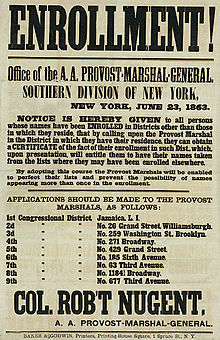New York City draft riots
Draft Riots is the name given to the violent riots that took place in New York from July 13-16, 1863, plunging the city into the worst chaos in its history up to that time.
The final trigger was probably the introduction of compulsory military service as a result of the American Civil War, which the 37th US Congress had passed in March 1863 with the Enrollment Act. A provision that made it possible to avoid compulsory military service by paying 300 dollars also aroused displeasure. The middle and lower classes then claimed that the American Civil War was the rich man's war and the poor man's fight ("a rich man's war and a poor man's fight"), although this seems to have been statistically refuted.
US President Lincoln had also ordered the freeing of slaves on January 1, 1863. The white population feared that black workers would give them strong competition in the labor market. Dark-skinned men were not drafted into the army because they were not considered citizens.
The Democratic party, which had been proclaiming its displeasure with the government for some time, had great influence in New York at that time. Horatio Seymour, the popular governor of New York State, fought vigorously against the emancipation of the slaves, against conscription, and criticized Abraham Lincoln's war policy.
More than 50,000 people, mostly Irish-born men from slum neighborhoods like Five Points, roamed the streets; some of them looted and committed crimes, including against blacks, whom they blamed for complicity in the civil war.
At least 120 people died (mostly rioters) and at least 300 were injured. More than 100 buildings were destroyed, including police stations, draft offices and the headquarters of the New York Tribune. Damage was estimated at $1.5 million.
After four days, the government managed to restore calm with the help of several regiments that had been detached to New York directly from the battlefield of Gettysburg and were under the command of John Adams Dix. The surviving ringleaders of the riots largely escaped punishment.
The decision of the New York City Council to provide 2.5 million dollars to buy the drafted conscripts out of the draft (out of 8,000 drafted New Yorkers, only 2,300 were actually drafted into the army) contributed to the calming of the situation. In terms of casualties, the Draft Riots surpassed the Los Angeles riots of 1992. In response to the riots, the city received several fortified forts.

Government troops fight with the mob

Soldiers shoot at looters

Recruiting Poster (June 23, 1863)
See also
- Gangs of New York: a Hollywood film (2002) that focuses on the riot.
- Gordon Riots (London, 1780): a Protestant uprising against a Catholic Emancipation Act.
Search within the encyclopedia